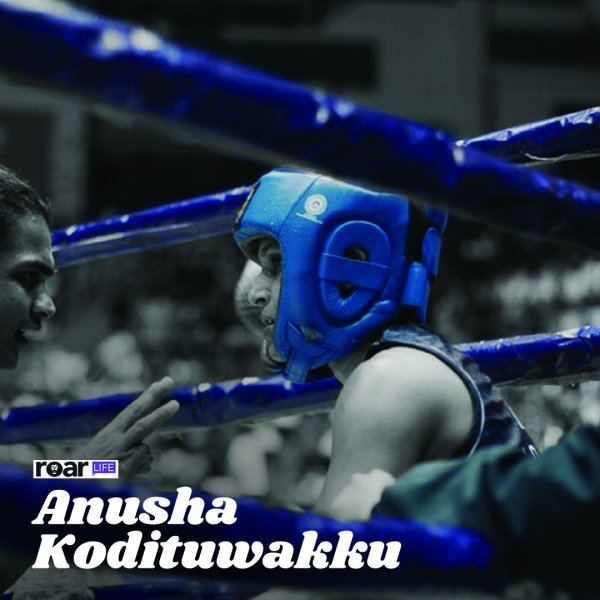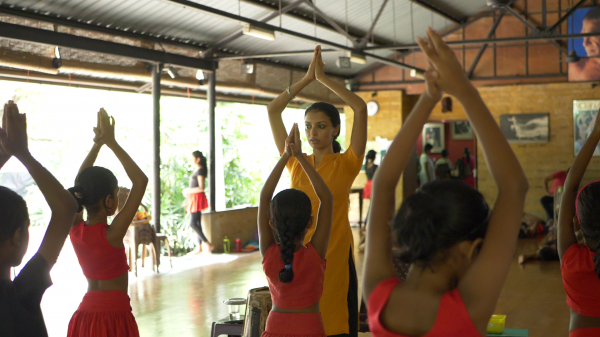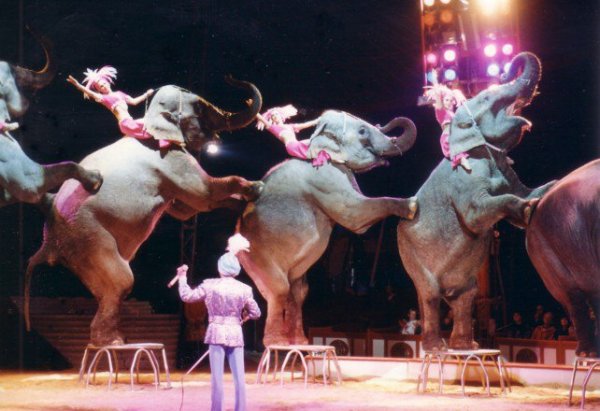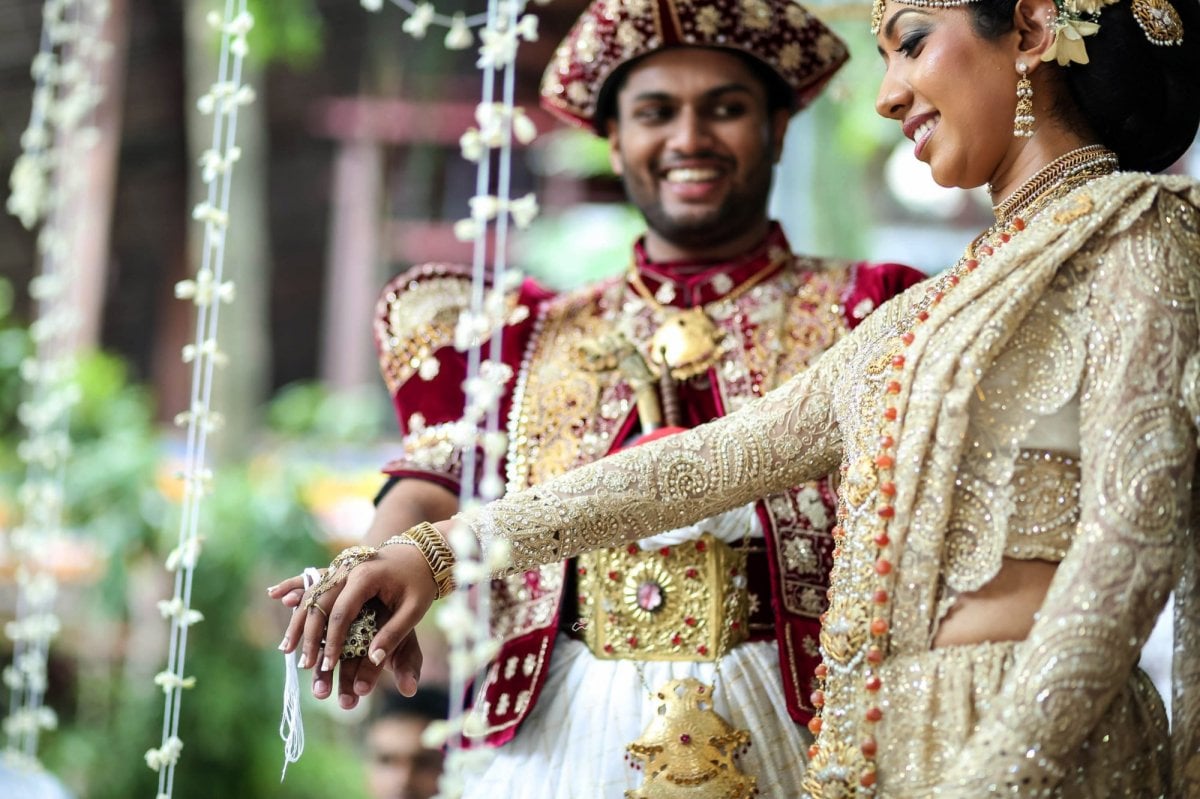
Weddings in Sri Lanka often take place with much pomp and ceremony and are the height of many social calendars, with relatives and friends of the marrying couple eagerly awaiting the big day of celebration. But they are also more than mere social events; a lot of thought goes into observing and performing the traditions which occupy significant roles in the ceremonies.
The traditional Sri Lankan Sinhala-Buddhist wedding ceremonies, for instance, involve many customs and rituals that have been passed down from generation to generation. Though Sinhala-Buddhist wedding ceremonies have been subject to change over the decades, some of the key features, such as observing the nekath and the poruwa siritha, remain unchanged.
The Nekath And The Poruwa
The Nekath, or the auspicious time, is a very important part of Buddhist wedding ceremonies. The date and the nekatha that the wedding ceremony should begin are decided by an astrologer after consulting the horoscopes of the bride and the groom. Even the nekatha at which each tradition or ritual should be performed at the ceremony is decided by an astrologer, based on the horoscopes of the couple.
A traditional Sinhala-Buddhist marriage ceremony is known as the poruwa siritha or poruwa ceremony. The poruwa itself is a decorated wooden platform that represents the house that the couple will share and is symbolic of their marriage and the start of a new life.
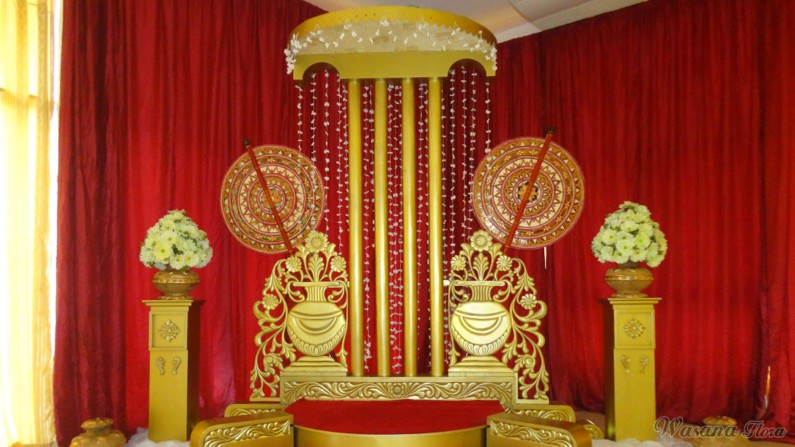
The poruwa is a decorated wooden platform that is symbolic of the union of marriage and the start of a new life. Image courtesy wasanaflora.com
The ceremony also involves many people: the shilpadhipathi (master of ceremonies or officiant), the ashtaka, or narrator, who recites religious chants (known as ashtaka) and the Jayamangala Gatha, a group of four young girls who bless the marriage with a traditional Buddhist chant, are some of the actors who play notable roles in the ceremony. Sometimes, Kandyan dancers and drummers perform during or in between the rituals.
Manjula Werapitiya, an ashtaka narrator who recites at poruwa ceremonies, explained that the poruwa marriage ceremony was recognised as a form of marriage registration in Sri Lanka until the British introduced the registration of marriages by law in 1870. Today, the poruwa siritha as well as the legal registration of marriage both take place at a traditional Buddhist wedding.
Werapitiya noted that a few changes have been made to Sinhalese wedding ceremonies over the years—a few traditions and rituals such as the making of the poruwa and the magul maduwa have been omitted, but the poruwa siritha is still the most important custom in a Sinhala-Buddhist wedding.
The Ceremony Begins
Many rituals and traditions which are symbolic and sacred to Buddhism are included in the poruwa ceremony and each one is conducted due to a specific belief. The ashtaka narrator recites religious chants throughout the ceremony while these rituals are performed.
At the given auspicious time, the ceremony begins; at first, the groom and his family gather at the right side of the poruwa, while the bride and her family gather at the left side. The bride and groom step onto the platform with their right foot first—at some wedding ceremonies this is done to the beat of drums and the sound of a conch shell—and they greet each other with palms held together.
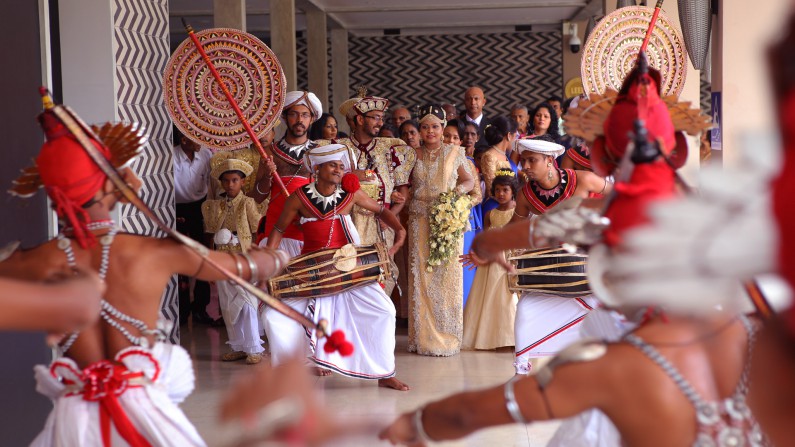
Some weddings, include performances by Kandyan dancers and drummers. Image courtesy yeah.lk
When the bride and groom stand next to each other on the platform, the shilpadhipathi presents a collection of betel leaves to them, which they accept and give back to him. Werapitiya explained that these betel leaves are a symbolic offering to the gods, particularly the God Ishta.
They are also presented with a tray bearing seven separate sheaves of betel leaves, with a coin placed on top of each sheaf for good luck. The bride and groom then take turns to pick up the leaves from each sheaf and drop it onto the platform.
“This custom,” said Werapitiya, “is practised to remember the seven generations of relatives of both the bride and the groom.”
The Tying Of The Pirith Nool
The tying of pirith nool (sacred thread) is a symbol of the union of marriage, and traditionally it was an equivalent to the modern signing of the marriage register. The little fingers of the couple are tied together with pirith nool or gold thread by a maternal uncle of the bride who then pours pirith pan (holy water) over their tied fingers.This ritual is significant because water and earth are two sacred elements in Buddhism and are considered to be eternal verities.

The tying of pirith nool symbolises the union of marriage. Image courtesy easyweddings.com.au
The Gifting Of White Cloth
After the pirith nool ritual, the groom presents a length of white cloth that is 32 riyan (about 16m) in length to the bride, which she, in turn, gives to her mother.
“The giving of this length of white cloth to the bride’s mother is an expression of the groom’s gratitude to his mother-in-law for raising the bride since her birth,” explained Werapitiya.
Milk And Kiribath
Much like the wedding cake that is a highlight of western and even some Eastern weddings, at a traditional Sinhala-Buddhist wedding it is the milk rice (kiribath) which is the most special dish out of all the sweetmeats that are a part of the wedding spread. The bride’s mother feeds the bride and groom a mouth of milk rice and the groom’s mother gives them each a sip of milk.
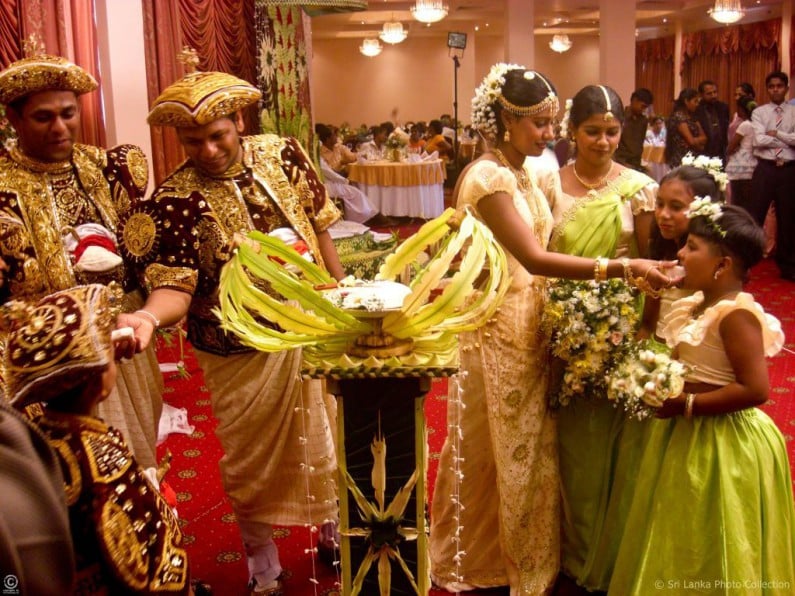
In a traditional Sinhala-Buddhist wedding, it is the milk rice which is the most special dish. Image courtesy srilankanweddingphoto.blogspot.com
“This ritual is significant because it symbolises the start of the bride and groom’s new life, as a married couple. As children, it was their mothers who fed them and gave them milk to drink, and this ritual signifies that they will be starting their new life together with the blessings of their mothers,” said Werapitiya.
After these traditions have been performed, the newly-wed couple can step down from the platform—again, with their right foot first—and the shilpadhipathi, along with a few members of the groom’s family, breaks a fresh coconut into two to bless the couple’s marriage, while the couple light the traditional oil lamp.
Modern Influences
Werapitiya also mentioned that several modern day customs have been absorbed into the poruwa ceremony over the years, such as the exchange of rings between the bride and the groom.
This custom has been borrowed from the western culture, and similar to the exchange of rings at a church wedding, the groom places a ring on the bride’s hand and then the bride places a ring on the groom’s hand, the only difference being that the couple performs this custom while standing in the middle of the poruwa.
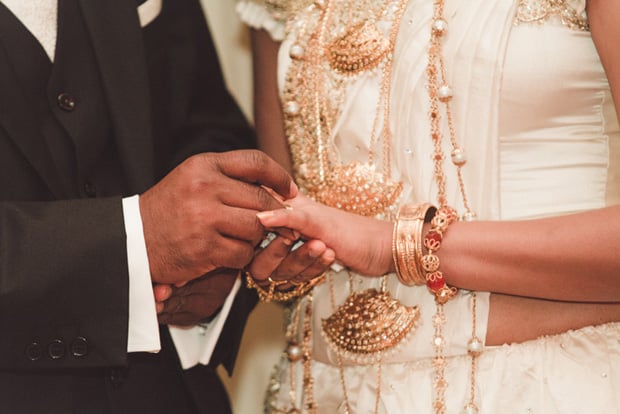
The exchange of wedding rings is a Western custom that has been absorbed into the traditional Sinhala-Buddhist poruwa ceremony. Image courtesy easyweddings.com.au
Another custom which has been integrated into contemporary Sinhala-Buddhist weddings is the giving of betel leaves from the bride to the groom. Before the couple steps down from the poruwa, the bride hands a sheaf of the leaves to the groom and worships him; according to Werapitiya, this is performed to signify the loyalty of the wife to her husband.
Werapitiya went on to note that, even the custom of the ‘homecoming ceremony’ that takes place a few days after the wedding ceremony is another newly-developed Sinhala-Buddhist wedding custom. At the poruwa ceremony, a saree and saree jacket, usually made of red material, are presented to the bride by the groom’s mother. This is the saree she will wear for the homecoming ceremony.
A Sinhala-Buddhist wedding is not merely a festive occasion for family members, relatives, and friends to celebrate a union of marriage between two people. They are also splendid occasions to observe many of the rituals and traditions that have been a part of the Sinhala-Buddhist culture in our country over a long period of time.
Editor’s note: This article previously identified the customs and traditions as ‘Sri Lankan Buddhist’. This has been corrected to ‘Sinhala-Buddhist’. We apologise for the error on our part.
Featured image courtesy thinkshaadi.com


